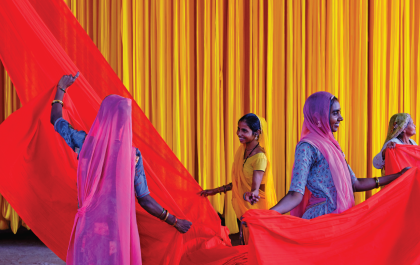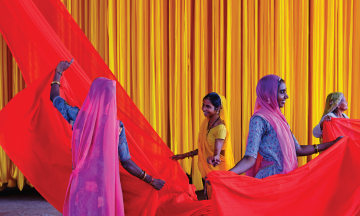In conversation with Ekushey Padak winner Kanak Chanpa Chakma
By Eshadi Sharif
The young, school-going Kanak Chanpa Chakma would go through school books with illustrations of Qayyum Chowdhury, Quamrul Hassan, Zainul Abedin, Hashem Khan, with the dream of just meeting the Bangladeshi pioneers in the realm of art.
Now, she is one of the most renowned names in Bangladesh’s art scene. The artist has completed 21 solo exhibitions and over 300 for group exhibitions, some even internationally in countries such as Bhutan, the US, India, Singapore, Thailand, South Korea, Japan. However, her most impressive achievement has to be winning the Ekushey Padak in 2023, the second highest civilian award in the country.
Kanak Chanpa Chakma’s art style can be described as abstract impressionistic. Many of her canvases carry the stories of women from indigenous communities, narrated in bold and bright colors. Being a nature lover herself, some of her paintings also reflect the bond between humans and mother earth.
The artist’s drive to capture these images that encapsulate the essence of Bangladesh, nature, and its indigenous communities and present them on canvases has earned her this prestigious award, for which she feels grateful.
The artist commented: “I’ve received many national and international awards, but when your country acknowledges you, the feeling of it is different. I think how I’ve been working for so many years with ethnic groups, coming from the hills and now working in the mainstream, it didn’t happen in one day. It took many years of hard work and struggles. I’m very grateful and happy.”
“When your country acknowledges you, the feeling of it is different”
True to her words, the humble and bright-eyed artist did not reach such heights overnight, but was rather uplifted by the support and encouragement of her family, mentors, and community.
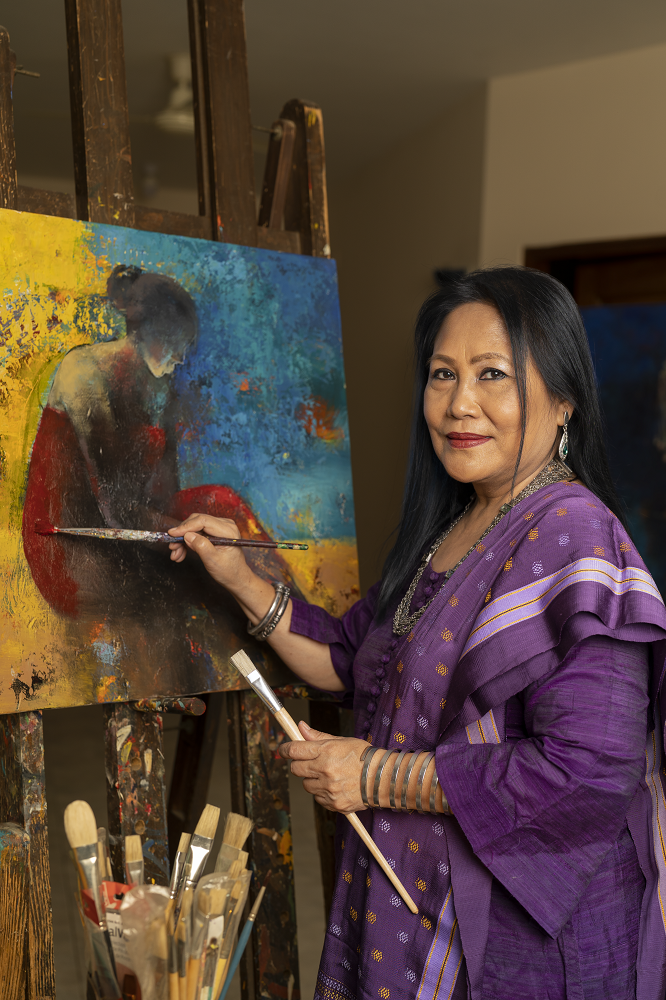

Kanak Chanpa Chakma was born and raised in the Rangamati Hill Tracts, and her knack for art appeared from a very young age. It did not matter that she did not have a canvas or acrylics; anything she could get her hands on became her pen and the world was her canvas.
The artist reminisces: “When I was two and a half to three years old, I hadn’t even started studying yet, I started drawing then. Back then paper and canvases weren’t widely available in Rangamati; I would draw in notebooks with my pencil and I’d use coal to draw on walls.”
In her school days, the young artist had dreamed of meeting famous Bangladeshi artists one day. Her scope of visiting galleries and participating in art competitions was limited as she only stayed in her area.
When she was in class 8, UNICEF had arranged an international art program, the prompt being “Tika diye shishu ke bachan” meaning, save children with vaccination. The young Kanak Chanpa had won the competition but could not go to Dhaka to receive the award. Two representatives from UNICEF had traveled all the way to her hometown to deliver the award personally. Her community and school were so proud of her achievement that they all came together to celebrate it, giving students the day off after two periods.
She comments with amazement: “The school ended the day early for me, it is something I couldn’t even imagine.”
The acknowledgement of her achievements seemed to be a catalyst in her career.
As her family supported her decision to pursue the arts and enrolled her in Charukola in 1978, she suddenly found herself among the very artists she once dreamed of meeting.
“I got a lot of support from my teachers such as Rafiqun Nabi, Hashem Khan, Qayyum Chowdhury, I got to meet them all. I felt like I had fulfilled my dream, whether I got established as an artist was a different matter.”
However, her journey has not always been smooth-sailing. The artist had greatly admired the works of Paul Gauguin; however, people would comment that her work was not unique.
Kanak Chanpa elaborates: “I was inspired by Paul Gauguin’s work and many people would comment, ‘Oh, your work is exactly like Paul Gauguin’s, you must copy his work.’ I just followed him, I learned from his style and gradually developed a style people can identify as Kanak Chanpa’s.”
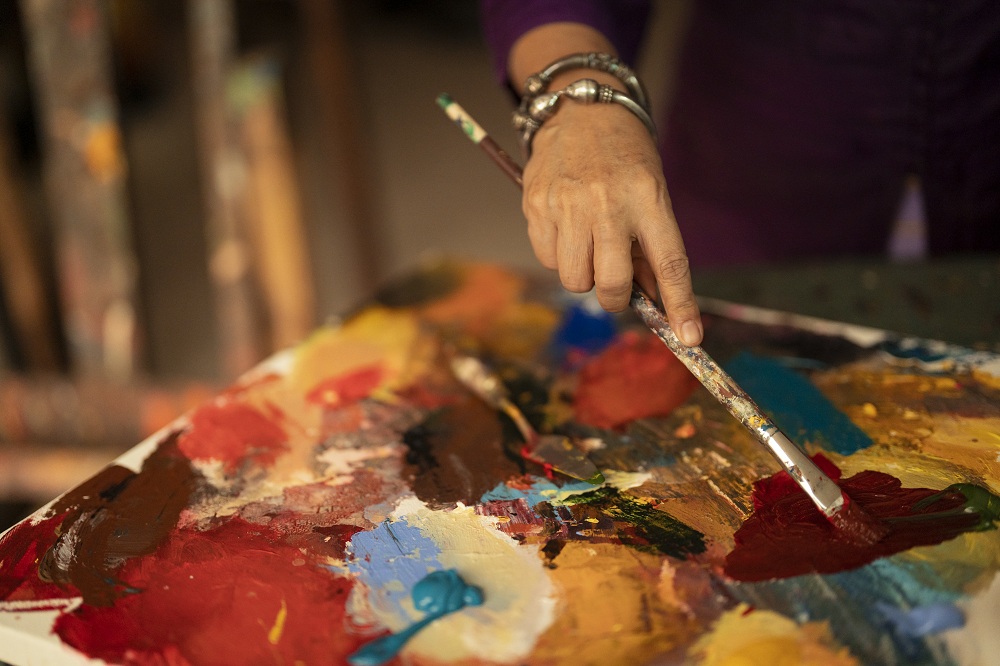
The artist dedicated much of her career exploring the different cultures of indigenous groups across the world. As Kanak moved forward with her career, she was able to tour countries such as the US and China for her fellowship. While touring America, she spent 15-20 days in Santa Fe and Albuquerque in New Mexico with Native Americans to learn about their culture.
She remembers how pivotal this experience was for her career: “I met painters, writers, and poets and met new people every day. This experience was a huge achievement, it added a lot to my life. I got to experience one or two of their festivals and felt that there were similarities with the festivals in our indigenous communities as well.” She continues: “Some of the motifs they use are completely the same as ours. Though the ornaments they wear are different, there are a few which are exactly the same as ours. I feel like in one way or another, there must be something similar in our roots.”
Her experiences exploring different indigenous cultures made her realize how, no matter how far apart they are on the map, there is a thread that connects them all. Whether it is festivities, ornaments, or their experiences, Kanak had discovered a common denominator. The artist later did a solo exhibition on Native Americans and Bangladeshi ethnic groups, where she translated these cultures in her art successfully.
“Painting is an international language. You might have to translate music, but you can understand paintings easily”
Kanak explains how her style changed a lot through this experience: “I feel like my work became bolder, free, rushing, the composition of the images became stronger.”
While Kanak Chanpa’s style evolved as she traveled and learned, there is still one noteworthy quality of her paintings that interests viewers. Most of her works portray women in bright colors. While her paintings have the rough, almost dream-like quality of impressionism, the ornaments the women wear are always detailed, creating a stark contrast with the rest of the painting.
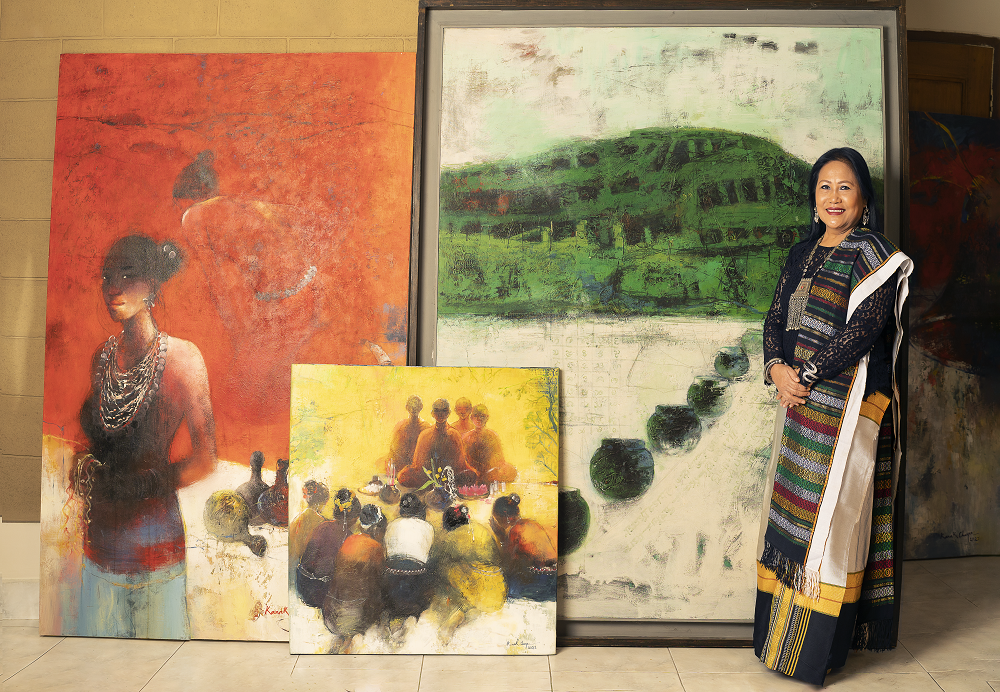
Kanak Chanpa elaborates on this: “I focus mostly on women as they are very deprived in our society, whether it’s in Bangladesh or indigenous society. In many cases, women work equally hard as men, if not more, but society still does not acknowledge it. Our country has improved a lot, but women’s safety still has not been ensured.”
She continues: “Men come upon the canvas as well but they come as objects, they are not the focal point. I choose to focus on women as they not only have beauty, they have rhythm and everything, and they also have an inner power. I believe they’re stronger than men, they give birth, they play a huge role in creating a family bond. We see women with only two hands but they have eight more hands like Durga.”
She also elaborates on how wearing flowers, ornaments, and bright colors are a part of life, especially for indigenous communities. She grew up seeing her mother dressing up before going to the temple during festivals. She comments: “Vibrant colors, flowers, and ornaments have also made my work more colorful.”
Even though she is the recipient of one of the most prestigious awards, it does not mean that she is done doing great things for society. She is quite active in social work and works with acid survivors, third-gender individuals, autistic children, deprived women, and many more. She also recently created the Ethnic Art Foundation for children of ethnic groups to have a platform in the arts. She also works in collaboration with many animal shelters, and is involved with animal rescue.
She commented: “When I got the Ekushey Padak I was honored, however, I also feel like my responsibilities have also increased. I have to express myself even stronger and not only that, I have to also work for society as well. As my country has given me such an honor, I should also work hard to contribute even more for my country.”
Kanak Chanpa Chakma’s story was not concocted from luck and miracles, rather from the joint support she received from her family and community along with sheer hard work. The key factor that makes her work stand out is quite simple, her empathy for people and nature connects with people, in a world where empathy is endangered.






